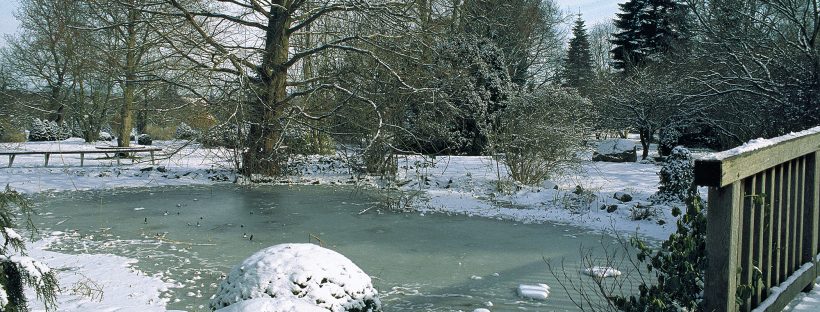
Preparing for Winter
Bare branches cast silhouettes against gray skies and crisp air hastens strides, curtailing time outdoors. Backyard views are appreciated through glass panes beneath layers of blankets.
But before winter’s cold calls us inside, pond care and cold weather preparation must adorn the top of pond owner’s to-do lists. A bit of planning and elbow grease—along with the right tools and equipment—will ensure ponds and their inhabitants remain protected from harsh temperatures.
For pond owners in colder climates, preparing for winter means planning to keep ponds de-iced and fish and plants protected until spring’s awaited return. An afternoon of winter prep goes a long way; you’ll be glad you invested the time once spring emerges.

If you choose to keep your pump running during colder months, ensure it is frost protected—such as OASE’s AquaMax Eco Premium—which withstands temperatures to -4°F. When the water temperature reaches 40°F (and before the first frost), move your frost-protected pump to mid-level depth. Circulating the deep water lowers temperatures and will cause stress on fish.
Take precautions against water freezing in plumbing during power outages. Remove filter lids and pads, allowing for pressure relief where possible. If your pump and filter can not withstand colder temperatures, turn it off, remove it, clean it and store it in a water-filled container in a climate controlled location.
If you applied pond netting to keep out autumn leaves, you’re ahead of the game. If you skipped fall prep, consider OASE’s PondNet for a quick daily skim of floating debris. Use EasyPick pond pliers to regularly remove leaves, sticks and other debris to keep your pond’s ecosystem balanced. Decaying organic matter deprives ponds of oxygen, impacting the health of plants and fish.
When the water temperature drops below 50°F, stop feeding fish. Consider a floating deicer if the pond is at risk of freezing solid—even a small hole in the ice will allow fish to breathe and allow pond gases to escape. In small ponds, ensure that warmer water zones where fish can survive are not recirculated. If ice forms in your pond, do not attempt to crack or break it; this will cause shock waves and will threaten the health of your fish.

Consider using OASE’s AquaOxy 450 with the OxyTex air diffuser to increase pond’s oxygen levels. OxyTex—a pond aerator and filter medium compatible with all OASE filters—works with AquaOxy 450 to inject air to ensure fish stock remains healthy.
OASE’s FlexiCut 2-in-1 pond scissors are ideal to trim overgrown vegetation around the pond’s perimeter—they stabilize while cutting to provide torque. Their long handle (5.2 ft.) enables easy maintenance in hard-to-reach areas.
Now, take time to sit back and relax. Pour some hot cocoa, add a log to the fire and enjoy the warmth!
Safety First
In the colder regions of the U.S. and Canada, when the temperature dips down into the freezing range, fish and plants can be left outdoors to hibernate naturally.
However, the freezing of the pond surface can create dangerous conditions for fish due to the accumulation of gas below the ice. Always ensure that there is a small hole in the ice cover, so that your fish, koi, or other inhabitants can breathe.
You should try to clean out as much organic debris as possible before the pond ices over and install an aerator, a deicer, or a heater to keep a hole in the ice. Even the smallest of holes will suffice. This allows oxygen in for the fish and plants and also allows any toxins to escape. Whatever you do, do not crack the ice using a hammer or other device. This will shock the fish and cause undue stress.
Water Temperature vs. Air Temperature
Water takes a long time to heat or cool compared to the air. This is why it is important for pond owners to go by the water temperature and not air temperature when it comes to caring for your pond. Water temperature is the determinant for seasonal preparation as well as feeding schedules for your fish or koi.
- At a water temperature of 60°F:
- Thoroughly remove organic debris from everything.
- Check power lines for cracks to prevent electrical hazards.
- Inspect the seal of the outer pump housing for leaks.
- Check the UVC bulb, which should be replaced annually.
- At a water temperature of 50°F:
- Stop feeding your fish.
- Trim and move hardy lilies to deeper water.
- At a water temperature of 40°F (before the first frost):
- Move your frost-protected pump to a plant shelf to prevent lowering the deep-water temperatures and causing undue stress on your fish or koi
- Store your non frost-protected pumps or anything, such as filters and uv clarifiers, that has glass or plastic inside, in a bucket of water in a frost-free location. This keeps the seals moist and debris residues from hardening.
- Install an aerator, deicer, or heater.

Modern Technology Defies Freezing Weather
Winter is the biggest threat to a pond and its’ equipment. In the winter there is ice; ice expands and can burst pipes and filter housings. Be sure to remove all points of the system where pressure can accumulate. Remove filter pads and lids from filters, allow for pressure relief in the system where possible.
The good news for pond enthusiasts: sub-zero temperatures cannot harm the AquaMax Eco Premium pump. It can be turned off but remain frozen in ice and snow without damage!
The following applies for all products that are not frost-proof: safeguard them from winter conditions accordingly! You should take pond pumps and filters out of the pond before the first frost. Store them in a place that will not allow freezing.
Read the original OASE Living Water Article here.


